The Waiting
Nothing. The Americans have not stepped up their attack. Three hours full of tension follow as the Concorde and Petrel are sighted approaching the city. Both are anchored 4,000 meters from the shore, six kilometers from San Antonio. An open mockery on the part of the Spanish artillery could provoke an immediate reaction. In this case, it would be best for the Spaniards not to furnish their enemy with a perfect excuse to open fire. At present, the art of provocation seems to be their only skill. It is difficult to refrain from criticizing the lethargy of the Spaniards. I am extremely tempted to use another term to define their attitude. Actually, every marine in this blockade dreams of a nocturnal attack on the American fleet as it lies anchored in the bay. Obviously, it is just a dream, since the logical consequence of a bombardment is retaliation. Why don’t the sailors on land arm the steam launches in the Pasig with torpedoes to use in the event of a surprise attack from these insolent Americans? If eight or ten steam launches fire on the Olympia or any other ship, one good hit would suffice to make the Americans uncomfortable.
The inertia of the Spaniards is beyond belief. An insurgent’s barge driven off-course by the typhoon of August 2 is now 600 meters from the Pasig. All one has to do is to take possession of it. On its foredeck is a 120mm cannon. There is much talk among the port authorities, but no one has acted.
Among the Spanish refugees on board the Adelaide, there are men who could be useful on land. One of them is this so-called photographer, who claims he is a correspondent for an illustrated magazine. And what about this captain of the artillery who has lost his right arm? He does not appear to be ill. Most of us on board think he should be on land. There is an armless hero called Cervantes, whose example he should follow.
